 |
 |
|
 |
New training video stresses safety measures for Adopt A Highway volunteers |
 |
 |
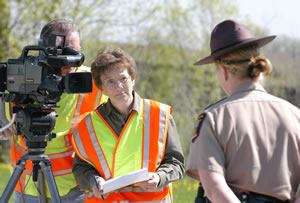 |
|
As Gary Andrist, Human Resources, videotapes, Jan Ekern, Office of Maintenance, interviews State Patrol Sgt. Jacalyn Sticha for a segment in the Adopt A Highway training video. Photo by David Gonzalez |
Jan Ekern assembled her cast, made sure they were properly outfitted with boots, orange vests, long-sleeved garments and plastic litter bags, then issued her final set of directions.
The actors, all Mn/DOT employees, fanned out as directed along Hwy 95 near Marine-on-St. Croix to pick up litter along the roadside.
As they worked, Gary Andrist, Human Resources, videotaped their efforts. David Gonzalez, Business Services, shot still photos. This scene and others filmed in different locations will be used in a training video for participants in the state’s Adopt A Highway program.
The program encompasses about 4,500 volunteer groups who have pledged to collect litter on about 9,000 miles of the state’s 12,000-mile highway system. Mn/DOT started the AAH volunteer program in 1990.
Ekern, partnerships coordinator with the Office of Maintenance, said the video will prepare AAH volunteers to do their work more safely.
“Our new video contains more emphasis on volunteer safety and new information on dealing with hazardous wastes, including those from illegal methamphetamine production,” she said.
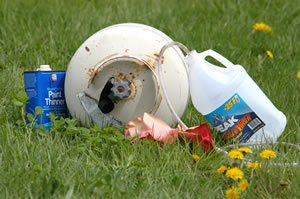 |
The Adopt A Highway training provides volunteers with examples of possible hazardous materials they may find when picking up trash. Photo by David Gonzalez |
The video includes interviews with Sgt. Jacalyn Sticha of the Mankato State Patrol District, and Dale Plemmons, Mankato/District 7’s safety officer. Their interviews were taped during a film session of workers removing litter along Hwy 169 near LeSueur.
Sticha stresses safe vehicle operation and parking in her appearance. Plemmons points out ways to recognize meth-related wastes, bio-medical waste products and other hazardous materials that volunteers may encounter.
As one crew started filming on Hwy 5 in Lake Elmo, members encountered a dead pheasant on the shoulder. The discovery, Ekern said, provided an impromptu opportunity for filming the video’s section about dealing with dead animals found in rights of way.
Tim Holtzman, supervisor at the Metro District’s Maple Grove truck station, supported the video by providing litter items such as a car muffler, shredded truck tires and a 2” by 4” piece of wood studded with rusty nails.
“Those nails sticking out of the 2” by 4” graphically remind us of the need to wear boots when collecting litter and following other safety rules as well,” she said.
Once editing and narration are finished, Ekern will send CD copies of the video to the district AAH coordinators for distribution to volunteer groups.
“We’ve learned a lot ourselves about the challenges of working along the roadsides while producing this video,” Ekern said. “We hope it will help our volunteer groups perform this community service more confidently and more safely.”
By Craig Wilkins
District volunteers take their AAH duties to the roadsides
 |
Bob Kotaska, an engineering specialist with District 4, loads bags of litter collected along Hwy 59 near Detroit Lakes during the district's spring roadside clean-up effort.
Photo by Judy Jacobs
|
Spring brings myriad changes to Minnesota—including the first round of litter pickups by volunteer groups. Employees from Detroit Lakes/District 4 and Baxter-St. Cloud/District 3 who have AAH volunteer groups were among them.
At Baxter, a group of employees and family members cleaned roadsides along Hwy 210 near Brainerd.
District 4 employees, retirees and their families also hit the roadsides early. About a score of employees, retirees and their families worked along Hwy 34 and Hwy 59 in Detroit Lakes. Bob Kotaska, an engineering specialist, provided his own trailer to carry the results of the afternoon’s work away.
Their efforts netted a trailer load of trash plus some additional finds. “Best Find” award honors went to Korgen Halver, who recovered golf balls, and Pam Gulseth who found six crumpled, but still spendable, one dollar bills.
|
|
back

|
 |
2006 session called productive, final commuter rail funding approved |
 |
 |
The 84th Minnesota State Legislature adjourned late Sunday, one day before the constitutional deadline and on time for the first time in three years. Gov. Tim Pawlenty characterized the session as a "productive" one that will help "position Minnesota for an even brighter future."
Pawlenty said the debate was mostly civil and cooperative and that the public should not let the stadiums for the Twins and Gophers overshadow other important bills that passed, including the $1 billion bonding bill.
“The bonding bill funds many important projects, including the final state piece in the Northstar commuter rail line, expanded prison space, the Rochester bioscience development center, improvements at the Minnesota Zoo and many excellent higher education projects," he said.
The commuter rail line will end right near the Target Center and the new Twins baseball stadium. Bob McFarlin, assistant to Lt. Gov./Commissioner Carol Molnau, said agency officials are optimistic that the Federal Transit Authority will quickly approve the project for final design, and later this year Congress will approve the funding package needed for Northstar.
"The state Legislature approved the governor’s full proposal of $60 million in state funding for the Northstar commuter rail from Big Lake to Minneapolis,” he said.
“Coincidentally, during the legislative session the state reached agreement with the BNSF Railway Company to host the Northstar service. These are two significant milestones in Northstar’s push to begin construction in 2007 and begin service in 2009.”
The bonding bill will also fund $71 million in local road and bridge improvements and will provide assistance for port development projects, rail initiatives and Greater Minnesota transit systems. The Metropolitan Council will receive nearly $56 million for bus rapid transit and transitway programs, including $7.8 million to continue planning a proposed light-rail or bus rapid-transit line in the Central Corridor between downtown Minneapolis and downtown St. Paul.
MVST amendment on deck
The transportation Omnibus Bill, which included a financing package for state highway projects and funds for a new Mn/DOT building in Mankato, did not pass through the Transportation Conference Committee despite significant support in both the House and Senate.
McFarlin said the MVST constitutional amendment effort—the proposal to ensure 100 percent of the state motor vehicle sales tax is dedicated to transportation—is the next step in achieving additional permanent funding for transportation.
"The proposed amendment was initiated by the governor and adopted by the Legislature in 2005. The Legislature discussed some proposed changes to the amendment this year, but took no action. The number one priority now is for all transportation advocates to work together to assure its adoption by voters this November," he said.
Eminent domain reform
The governor last week signed a bill that will make it harder for government to take private property and make it much easier for property owners to ensure that they are justly compensated for the land they must sell for the public’s benefit. The bill also limits the use of eminent domain to the acquisition of property that will be owned by the government, used for the functioning of public service corporations, such as utilities or railroads or, in limited cases, for economic development to remedy blighted, environmentally contaminated or abandoned land.
"This legislation will have significant impact on the process Mn/DOT follows when using eminent domain to buy right of way for transportation projects," said Betsy Parker, Government Affairs director.
Parker said Mn/DOT is developing new land acquisition processes to comply with the new requirements.
“Mn/DOT must reconcile its duty to use taxpayer resources wisely with its obligation and commitment to make sure that landowners are treated fairly and compensated to the full extent provided by law,” she said.
For more information about the legislative session, visit the Government Affairs site at http://ihub.dot.state.mn.us/information/legislative2006/index.html.
By Jeanne Aamodt
|
back

|
 |
Omnibus survey results show steady improvement in service ratings |
 |
 |
Minnesotans are generally pleased with the level of highway maintenance services that Mn/DOT provides, according to the annual statewide Omnibus Survey.
Mn/DOT conducts the annual poll to measure and track state residents’ satisfaction with services the agency provides.
The survey also measures public opinion about new initiatives such as dedicating all motor vehicle sales tax revenue to transportation-related purposes or implementing the new Safe Routes to School program.
Lori Laflin, senior market research analyst, Office of Investment Management, said the survey shows higher ratings in 2005 than in 2001 for services such as overall highway maintenance and keeping road surfaces smooth.
She said, however, that both categories remain slightly below Mn/DOT’s performance target levels.
Poll results also indicate higher ratings in areas such as litter removal and the visibility of signs and other road markers.
Mn/DOT’s communications efforts also show an upward trend in perceived reliability. This rating increased from 49 percent in 2001 to 57 percent in 2005.
Survey responses also show that work zone safety messages are reaching the majority of the public. Responses show, however, that while many can accurately recall their general intent, fewer respondents can recall the associated safety slogans.
The survey also indicates that one-half to two-thirds of respondents who use Mn/DOT-supported travel information services found them to be “very useful.” Users of electronic freeway message signs, KBEM-FM traffic radio in the Twin Cities, Mn/DOT’s Web site, road signs and the 511 Traveler Information Service are more likely to view the department’s services as the most reliable sources of information.
Laflin notes, however, that changes in poll results compared with 2004 show a drop in the use of electronic highway signs statewide, an increase in the use of Mn/DOT’s Web site in the Twin Cities metro area and a decrease in the perceived usefulness of the Web site in Greater Minnesota.
The survey also examined topical issues such as toll lanes and dedicating all revenue from the motor vehicle sales tax to transportation.
Results showed that desire for having the option to use a toll lane declined in the second year it was measured. Positive responses dropped from 55 percent to 48 percent statewide and from 54 percent to 46 percent in Twin Cities metro area respondents.
Support far outweighs opposition, however, for using MVST revenues for transportation purposes. More than seven in 10 individuals statewide say they support the proposal either “somewhat” or “strongly,” according to Laflin.
Bob Winter, District Operations Division director, said the survey results are encouraging.
“The poll shows us that we are making modest improvements,” Winter said.
He said some findings indicate the public is satisfied with performance levels in some areas that Mn/DOT is currently working to improve.
Winter said, for example, the poll shows a positive response for highway signing while the department strives to reduce the sign replacement cycle from 15 to 12 years.
“Based on the survey and our use of new, longer-lasting sign sheeting, we may be able to keep the replacement cycle at 15 years,” he said.
The biggest challenge from the survey, Winter said, is turning the information into action.
“The Omnibus Survey, plus tracking trends and measuring our performance levels, helps us support our decisions about how we allocate resources to meet our transportation system’s future needs,” he said.
By Craig Wilkins
|
back

|
 |
Steve Lund named state maintenance engineer |
 |
 |
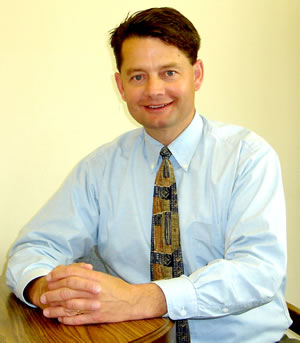 |
|
Steve Lund becomes the state maintenance engineer effective June 5.
Photo by Kristine Hernandez |
Steve Lund, currently an assistant district engineer with Rochester/District 6, will lead the Office of Maintenance beginning June 5.
He succeeds Rick Arnebeck, who was named as director of the Operations, Safety and Technology Division in April.
Curt Gobeli will continue to serve as acting director until Lund’s appointment begins.
Lund brings 22 years of experience in engineering, research and management to his new position.
He has held various positions in research, construction and maintenance in the Central Office, the Metro District and at Rochester.
Lund also served as a legislative assistant during a 1992 mobility assignment with the Office of Government Relations.
Lund’s maintenance experience includes serving as a research operations engineer with the Office of Maintenance, a maintenance operations engineer with Metro District and as the area maintenance engineer with District 6, which he accepted in 2001.
Subsequently, his duties expanded to include managing construction, fleet operations and facilities management with the district.
Lund’s first experience as a Mn/DOT employee was from 1979 until 1981 when he served as a student worker at District 1’s Nopeming truck station near Duluth, his hometown.
Lund holds a bachelor’s degree in civil engineering from the University of Minnesota. He lives with his family in Hastings.
Lund’s office in the Central Office; his new phone number will be 651/297-3590.
|
back

|
 |
Commuter choice events focus on biking, walking |
 |
 |
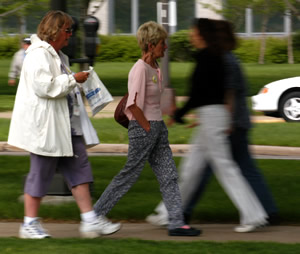 |
|
Cindy Etienne and Karen Breen, Mn/DOT’s Office of Transit, join other state employees on a “Walk Around the Capitol” May 10. Photo by David Gonzalez |
Many Minnesotans left their cars at home and biked or walked to work during recent events to promote alternate modes of transportation. Gov. Tim Pawlenty issued a proclamation naming May 14–20 as Bike Safely to Work Week. May is also the 50th anniversary of national bike month.
Mn/DOT sponsored a “Walk Around the Capitol” on May 10 for all capitol complex state agency employees, and on May 19, Mn/DOT was involved in Bike Safely to Work Day events in St. Paul, Duluth and Rochester.
“Events were very well-attended,” Bob Works, head of Mn/DOT’s Office of Transit bike and pedestrian section, told a reporter from the Twin Cities Metro area’s KARE11-TV. “I think gas prices and the focus on fitness benefits were the main reason. Some people were riding their bikes to work for the very first time.”
Biking can also help improve health and bring commuters closer to nature.
“Biking helped me turn my health around a number of years ago,” said Works, who occasionally commutes to work in St. Paul from Bloomington. “Now I’m more fit than I’ve ever been. I love it!”
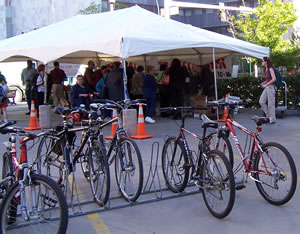 |
| Rochester bike, bus and carpool commuters stop for prizes and refreshments at a May 18 downtown event sponsored by Mn/DOT, the City of Rochester, local businesses and organizations. Photo by Kristine Hernandez |
Bike Safely to Work week events reinforced Minnesota's "Share the Road" bicycle safety education program aimed at educating the public about eight “rules of road” to help adult bicyclists and motorists share the road more safely:
- Bicyclists may ride on all Minnesota roads, except where restricted.
- Bicyclists should ride on the road, and must ride in the same direction as traffic.
- Motorists must at all times maintain a three-foot clearance when passing a bicyclist.
- Bicyclists must obey all traffic control signs and signals, just as motorists.
- Motorists and bicyclists must yield the right-of-way to each other.
- Bicyclists should signal their turns and should ride in a predictable manner.
- Lights and reflectors are required at night.
- Bicyclists should always wear helmets.
For more information about the “Share the Road” bicycle safety education program, go to www.sharetheroadmn.org/biketowork.html.
By Donna Lindberg
|
back

|
 |
Sponge-like pavement overlay will release anti-icing chemicals when needed |
 |
 |
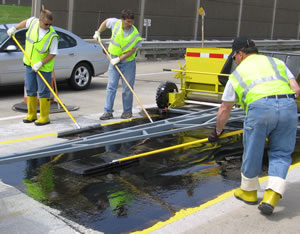 |
|
Duluth/District 1 this winter will test a new, chemical-absorbing overlay on two Hwy 169 bridges in Hibbing. The overlay, known as SafeLane, is made with epoxy-bound aggregate. Photo courtesy of Cargill |
Duluth/District 1 this winter will test a new, chemical-absorbing overlay that holds anti-icing chemicals until excess moisture triggers their release.
The district will field test the overlay made with epoxy-bound aggregate on two Hwy 169 bridges in Hibbing.
Because of its absorbency, the material can hold anti-icing chemicals until they are needed, reducing the number of chemical applications needed.
The overlay known as SafeLane was developed by Cargill, Inc. of Minnetonka.
Duane Hill, assistant district engineer for operations, said the overlay will be used on the westbound lanes of Hwy 169 where a set of bridges over railroads frequently experiences icing conditions.
The eastbound lanes of the two-mile section of highway will not use SafeLane. It will serve as a control measure for the test.
Testing will determine how well the overlay increases skid resistance and reduces crash rates on the bridges and a connecting, curved section of the highway.
Hill said the district’s highway and bridge maintenance workers will install the new pavement in late July. They will repair deteriorated concrete and use shot blasting to provide a clean, durable surface to ensure a good bond for the overlay.
The SafeLane overlay consists of a thin epoxy coating that is spread on the bridge deck topped with a layer of porous limestone aggregate. The overlay’s thickness will be three-eighths of an inch.
Cost of the test section will be about $100,000. Hill said the paving materials will cost about $50,000 and Mn/DOT’s labor costs will be approximately $100,000 for labor and material costs. Research to measure the overlay’s performance will cost an additional $50,000 to $100,000.
One aspect of the research will test the overlay’s durability on a high-speed route.
The pavement, Hill said, will be treated with various anti-icing chemicals such as brine and magnesium chloride to gauge their effectiveness.
The district is testing another SafeLane application on an I-535 exit ramp from the Blatnik Bridge in Duluth.
Hill said anecdotal evidence shows an increase in skid reduction and a drop in crash rates on the ramp.
“The controlled test on Hwy 169 will show us how the pavement and anti-icing chemicals prevent icing and how the pavement stands up to higher speeds than on the I-535 ramp and to standard highway maintenance practices in the region,” he said.
By Craig Wilkins
|
back

|
 |
OFCVO is on the road again |
 |
 |
The Office of Freight and Commercial Vehicle Operations is moving from the Administrative Truck Center in Mendota Heights to the first floor of the Transportation Building in St. Paul. The move will take place May 30 to June 4.
"This move allows us to occupy space available within Central Office and save $350,000 in annual rent payments,” said Cecil Selness, OFCVO director. “In these tight fiscal times, those savings will help us cover our other rising costs."
OFCVO includes Mn/DOT’s Freight, Railroads & Waterways and Commercial Vehicle Operations sections. The Freight, Railroads & Waterways section manages activities that affect multi-modal freight movements and the use of private rail systems for passenger service in Minnesota, and manages port development activities. The Commercial Vehicle Operations section administers and enforces safety regulations for motor carriers operating in and through Minnesota. It also provides training statewide in such areas as truck and special transportation services regulations, commercial vehicle driver qualifications, drug and alcohol testing, and more.
“The move involves 65 of our employees,” Selness said. “However, 10 field enforcement employees currently based in Mendota Heights will work out of ‘home base’ offices in Hastings, Oakdale, Golden Valley and other Metro locations.”
OFCVO is one of the few Mn/DOT offices that provides services to customers in person, on the Web and by phone. A separate OFCVO receptionist will be located on the first floor of the Transportation Building to serve walk-in customers. Also, since more truckers are doing business on the Web, only one parking space will be provided for semis. Semi parking is located north of the main Sears Building off Rice Street.
“Some of the services F&CVO provides are timely or even critical, such as issuing permits, doing safety inspections and regulating the movement of hazardous materials,” Selness said. “We have notified our customers of our move so they can be prepared for a reduced level of service that may occur during our move and for about a week afterward.”
OFCVO partners with the Minnesota Department of Public Safety and other agencies and organizations for some of the services it provides. DPS’s State Patrol Commercial Vehicle section will remain at the Mendota Heights location. Other services can be accessed through the Web at http://www.dot.state.mn.us/cvo/index.html.
For more information about the OFCVO move, go to http://www.dot.state.mn.us/cvo/moving.html.
By Donna Lindberg
|
back

|
 |
|
 |



